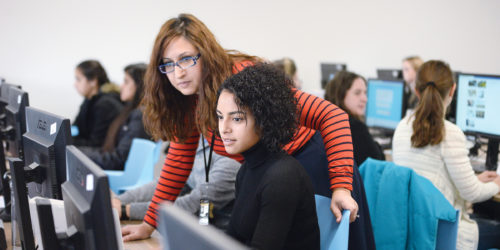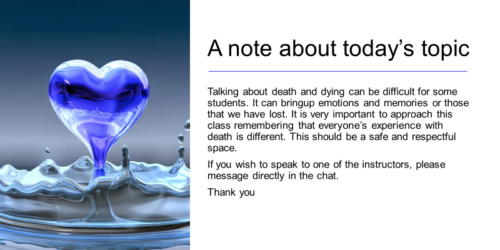
Teaching with Sign Language Interpreters (SLIs) or Interpreters in the Classroom
Introduction
As of 2021, there are approximately 382,700 deaf and 3,827,000 hard of hearing people in Canada (Canadian Association of the Deaf, n.d.; Malkowski, 2021). Deaf, hard of hearing, and deafened individuals (D/HH) are a valued part of our Conestoga community (for more information, see this resource for terms and this resource for deaf community and culture). As faculty continue to teach at Conestoga, many may have a student who is part of the D/HH community. This teaching tip supports faculty in welcoming D/HH students and interpreters into an inclusive learning space for all.
How do I know if I have a deaf or hard of hearing (D/HH) student in my course?
If a student requires an accommodation in their learning environment, the student will be registered with Conestoga’s Accessible Learning department. As per Conestoga’s Student Accommodation Policy and Student Accommodation Procedure, faculty members will be notified that a student in a course they are teaching requires accommodations. This notification will come in the form of an email to the faculty’s Conestoga work email, with instructions on how to read and acknowledge receiving the accommodations via the Accommodate Portal.
What is a Sign Language Interpreter (SLI)/Interpreter and what can I expect?
A D/HH student may require a Sign Language Interpreter (SLI) or Interpreter to be present in the classroom/learning environment. Interpreters’ primary objective is to ensure that communication is clear and precise, allowing for effective understanding and dialogue. They achieve this by explaining what they are hearing from the faculty and from students to the student using American Sign Language as clearly and precisely as possible. As well, they can explain what the D/HH student may want to share with the faculty and/or class/ other students.
Often, interpreters work as a team. Interpreting is hard work, and you can expect more than one interpreter in a longer class period to give each other a break.
What are essential tips for faculty collaborating with SLIs/Interpreters in the learning space?
When working with interpreters or SLIs, it is important for faculty to follow the below tips to enhance inclusivity and accessibility for all:
- Communicate directly with the Deaf/Hard of Hearing (D/HH) Student: To enhance accessibility and understanding, when addressing a student who is Deaf or hard of hearing, speak directly to them, facing them and making eye contact. Avoid using phrases addressed to the interpreter (such as “tell him/her/them”). The interpreter will convey what is being said or signed already.
- Interpreter positioning in classrooms: SLIs will position themselves close to the faculty, the board, the front of the classroom, and/or multimedia equipment. This allows for the clearest line of sight for D/HH students learning with the interpreter. As faculty, be sure to not position yourself in between the line of sight of the students and the interpreter.
- Provide learning materials in advance: Interpreters, just like all students, benefit from gaining access to teaching materials in advance, at least 48 hours prior to teaching (in line with accessibility requirements). Providing prompt access to learning materials is especially important for interpreters to prepare and convey messages clearly for D/HH learners.
- Use Closed Captions: When incorporating video or audio learning materials in the classroom or learning space (e.g., synchronous lesson or on eConestoga), faculty should ensure that high quality closed captions are provided. For support with closed captions, see Digital Tool kits on the Library & Learning Services website (Adding Closed Captioning to Videos – Digital Skills Toolkit – Library & Learning Services at Conestoga College, Accessible Media – Assistive Technologies, Alternate Formats & Technologies to Help You Learn – Library & Learning Services at Conestoga College).
- Ensure one person speaks at a time: To ensure communication is not missed, monitor class discussions so everyone speaks clearly, taking turns. Set a class guideline that all students need to raise their hands if they want to respond, ask a question, or share with the class.
- Pace your teaching: Keep in mind that with all students, an enhanced teaching pace can present additional barriers to student learning and understanding. Faculty’s teaching pace is of particular importance with D/HH students and SLIs, as interpreting can include a slight delay. As such, faculty should be mindful of their teaching pace, as well as the pace of class discussions involving input from numerous students.
- Support meaning and understanding: Interpreters recognize that meaning isn’t always straightforward. If information isn’t clear to the student, they make adjustments to their interpreting approach. They may present information differently, or they may seek clarification from you. As with students, faculty should be ready to further explain to the interpreter if meaning and understanding can be enhanced.
- Provide breaks: All students and faculty are entitled to a 10-minutes break for each 50-minutes of teaching. Interpreters and D/HH students are no exception. Such breaks, in fact, are of particular importance with interpreting, which can be mentally and physically strenuous. Thus, ensuring regular breaks will ensure the D/HH student doesn’t miss important information.
Summary
Working with Sign Language Interpreters or interpreters is an important way for faculty to meet the accommodation of D/HH students. Faculty should be patient and open-minded, understanding that effective communication involves being proactive and adaptive to the tips provided in this hub post.
If you have further questions about interpreting or sign language, please contact Kristina Pelletier, the Resources Supervisor within Accessible Learning Services, at Kpelletier@conestogac.on.ca.
Additional Resources
Below are key resources provided by Kristina Pelletier, to further support faculty in collaborating with interpreters and teaching D/HH students:
References
Canadian Association of the Deaf – Association Des Sourds du Canada. (2015). Statistics on Deaf Canadians.Retrieved on Apr 16, 2024 from: https://cad.ca/issues-positions/statistics-on-deaf-canadians/
Disabilities, Opportunities, Internetworking, and Technology. (May 24, 2022). How are the terms deaf, deafened, hard of hearing, and hearing impaired typically used? Retrieved on Apr 16, 2024 from: https://www.washington.edu/doit/how-are-terms-deaf-deafened-hard-hearing-and-hearing-impaired-typically-used
Malkowski, G. (2021). 2021 Canadian Population: Deaf and Hard of Hearing Statistics (Statistics Canada). [Document]. Statistics Canada.
National Association of the Deaf. (n.d.). Community and Culture – Frequently Asked Questions. Retrieved on Apr 16, 2024 from: https://www.nad.org/resources/american-sign-language/community-and-culture-frequently-asked-questions/






